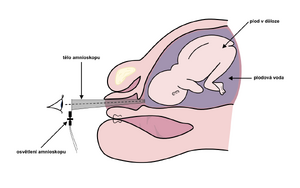Amnioscopy
From WikiLectures
Amnioscopy is an endoscopic examination method used in obstetrics, where the quality and color of the amniotic fluid is visually examined using an amnioscope. The amnioscope is a conically tapering tube with a light source, which is introduced through the vagina and the canal of the cervix to the lower pole of the sac of membranes. Physiologically, the amniotic fluid is clear, it may contain amniotic fluid flakes. A different color of the amniotic fluid points to the possibility of an intrauterine threat to the fetus. As a standard, amnioscopy is performed when the mother is admitted to the delivery room (so-called entrance amnioscopy).
- The green color of the amniotic fluid can signal hypoxia of the fetus (the green color is conditioned by the leakage of meconium from the intestine; cardiotocography and ultrasound flowmetry are much more perfect methods of detecting hypoxia of the fetus).
- Yellow coloration of the amniotic fluid can signal a hemolytic disease of the fetus in Rh-isoimmunization.
- Brown coloration of the amniotic fluid may signal intrauterine death of the fetus.
![]() Only the anterior amniotic fluid can be examined with an amnioscope.
Only the anterior amniotic fluid can be examined with an amnioscope.
Links[edit | edit source]
Related articles[edit | edit source]
Literature[edit | edit source]
- ČECH, Evžen – MARŠÁL, Zdeněk, et al. Porodnictví. 1. edition. Praha : Grada, 1999. ISBN 80-7169-355-3.

